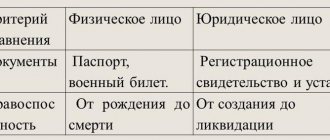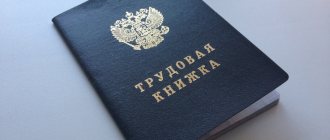Introductory information
The regulatory legal act that now regulates cash management is Bank of Russia Directive No. 3210-U dated March 11, 2014 “On the procedure for conducting cash transactions by legal entities and the simplified procedure for conducting cash transactions by individual entrepreneurs and small businesses.”
It was adopted to replace the expired Bank of Russia Regulation No. 373-P dated October 12, 2011 “On the procedure for conducting cash transactions with banknotes and coins of the Bank of Russia on the territory of the Russian Federation” (see “New rules of cash discipline: what will change in 2012”). The first information about it appeared in the fall of 2013, when the draft of this document was posted on the website of the Central Bank of the Russian Federation. The long wait took place under the slogan of complete liberation of individual entrepreneurs from cash discipline. However, complete liberation did not occur. Individual entrepreneurs were allowed not to apply a cash balance limit, not to draw up cash documents and not to maintain a cash book. Otherwise, entrepreneurs must fully comply with the rules for conducting cash transactions.
Maintain a cash book in a web service for free
The document has become a little shorter and more concise. Many formulations have been clarified, which previously gave room for the imagination of those who like to change any restriction in their favor.
Which document regulates settlements with funds?
At the time of writing, the following documents regulate:
Regulation of the Central Bank of the Russian Federation dated June 19, 2012 No. 383-P “Regulations on the rules for transferring funds” (hereinafter referred to as Regulation No. 383-P). We are talking about settlements by payment orders, letters of credit, collection orders, settlements by checks, direct debits (settlements in the form of transfer of funds at the request of the recipient of funds), settlements in the form of transfer of electronic funds.
1. Application of cash registers - Federal Law of May 22, 2003 N 54-FZ “On the use of cash register equipment when making cash payments and (or) payments using payment cards.” Not all individual entrepreneurs need to use a cash register; more about this in our article “How to register a cash register.”
Individual entrepreneurs and small businesses do not set a cash balance limit
The text of the instructions says: “individual entrepreneurs and small businesses may not set a cash balance limit.”
In addition, all points of the instruction that relate to the calculation, approval and application of the limit are aimed exclusively at legal entities. The words “individual entrepreneur” have been removed from these parts of the text. So everything is clear with individual entrepreneurs - they should not set a limit, and the new order does not allow any discrepancies in this matter.
The question remains: who are small businesses that are also exempt from the obligation to set a limit? In search of an answer to this question, the instructions refer us to the Federal Law of July 24, 2007 No. 209-FZ “On the development of small and medium-sized businesses in the Russian Federation.” According to this law, small businesses include commercial organizations in which the share of participation of individuals is at least 75%, the number of employees is not more than 100 people, and the proceeds from the sale of goods, works or services excluding VAT do not exceed 400 million rubles (Article 4 of the Federal Law of July 24, 2007 No. 209-FZ). Accordingly, individual entrepreneurs and small businesses do not set a cash balance limit for themselves and do not comply with it.
At the same time, it is necessary to note a small subtlety that arises from the phrase “may not be installed.” It turns out that they may not install it, or they may install it. For example, to strengthen cashier discipline and safety rules when working with cash.
The difficulty lies in the differences between the individual entrepreneur and the organization that will set the limit voluntarily. If such a limit is set by an individual entrepreneur, then this will be his internal document, and exceeding such a limit does not face any sanctions. Another thing is organization. In the opinion of the author of these lines, if she voluntarily sets a limit for herself, this will mean that she waives her right to simplified cash transactions and must comply with all the rules and restrictions associated with the calculation, approval and application of the cash balance limit. And for exceeding this limit, such small enterprises will be punished just as harshly as “big” ones. The likelihood of just such a reading of the new rules is very high.
Let us immediately note that for small businesses, the non-application of a cash balance limit is the only “simplification” of the procedure for conducting cash transactions. Otherwise, they must fully comply with all the rules established for legal entities.
Who should keep a cash register?
Is a cashier's journal necessary if the entrepreneur works himself? According to the general rules for maintaining accounting documentation, cash transactions are recorded by the cashier. He is a financially responsible employee and in case of a shortage he will be fined in accordance with the rules of the Labor Code of the Russian Federation.
All responsibility for the correct maintenance of the register of the cashier of the individual entrepreneur also lies with him. At the end of each working day, the cashier hands over the journal to the chief accountant, who signs and closes the day. If the company does not have an accountant, then its duties are performed by the manager (entrepreneur).
Individual entrepreneurs may not issue cash receipts and debit orders and may not maintain a cash book
To be extremely precise, the exemption does not apply to all individual entrepreneurs, but only to those who, in accordance with tax legislation, keep records of income, or income and expenses, or other objects of taxation, or physical indicators.
A rather ornate definition, which, apparently, should be examined more closely.
Depending on the taxation system, individual entrepreneurs are required to keep records of:
- OSNO - based on the Book of Income and Expenses and Business Operations of an individual entrepreneur;
- Unified Agricultural Tax - based on the Book of Income and Expenses;
- STS - based on the Book of Income and Expenses;
- PSN - based on the Income Accounting Book.
Maintain separate accounting when combining simplified taxation system and PSN and prepare reports
The only tax system in which an individual entrepreneur does not keep records of income or income and expenses is UTII. But this system does not provide for such accounting. In the tax return for UTII, the entrepreneur enters physical indicators, on the basis of which the tax is determined. Consequently, in this system, the individual entrepreneur keeps records of physical indicators, which is also taken into account in a complex formulation. It turns out that under any tax system, an individual entrepreneur has the right not to draw up cash receipts and expenditures, as well as a cash book.
Perhaps, over time, it will be clarified who exactly the authors of the Directive of the Central Bank of the Russian Federation had in mind “outside the brackets” of such a definition. For now, we will proceed from the fact that this “simplification” applies to all individual entrepreneurs without exception.
Changes for entrepreneurs
You don’t have to set a cash balance limit at the cash register
Individual entrepreneurs no longer need to calculate the cash balance limit. According to the new procedure, businessmen do not have to set a cash limit (paragraph 10, paragraph 2 of the new procedure). What does it mean? Since there is no limit, then at the end of the working day you have the right to leave any amount of money in the cash register without any restrictions and for any period of time.
Well, of course, in the interests of preserving property, we believe it is best to organize periodic deposits of money to the bank. Or you can take money from the cash register more often for your personal needs. Moreover, now this is directly permitted by law (Instruction of the Central Bank dated October 7, 2013 No. 3073-U “On cash payments”).
It is allowed not to draw up cash documents and books
As we have already said, entrepreneurs may not set a cash limit. In addition, two more concessions are provided for them. First: it is allowed not to draw up cash documents. That is, do not write out a cash outflow order when issuing money from the cash register and a cash inflow order when accepting “cash”. Second: you don’t have to keep a cash book. Any of the concessions can be applied if the merchant, in accordance with tax legislation, records income, expenses, physical indicators or other objects of taxation. This is stated in paragraph 2 of subclause 4.1 and paragraph 9 of subclause 4.6 of clause 4 of the new order.
That is, it turns out that this relaxation applies to all individual entrepreneurs, regardless of what tax regime they apply. In particular, this applies to those businessmen who work under the general regime, simplified tax system or patent. Since they keep the Book of Income and Expenses (clause 2 of Article 54, Article 346.24 and clause 1 of Article 346.53 of the Tax Code of the Russian Federation). And also for entrepreneurs on UTII, since they keep records of the physical indicators necessary to calculate this tax (clause 9 of Article 346.29 of the Tax Code of the Russian Federation).
Let us remind you that entrepreneurs do not do accounting. And the balance sheet is not made up
Therefore, it is not so important for a businessman to record cash flows and withdraw balances, especially since all the money is his property and there is no need to report to anyone for it
However, in our opinion, it is advisable to refuse to fully conduct cash transactions only if the entrepreneur works alone, he does not have employees, he does not issue funds on account and does not pay wages. Then - yes, all the documents for the cash register that he wrote out for himself are extra pieces of paper.
If an entrepreneur has employees, then he must already keep records of what is paid to whom and on what grounds. He also needs to supervise the work of the cashier - if there is one. Accordingly, it is impossible to do without taking into account the receipt and expenditure of all cash - at least in order to exclude cases of theft. This means that a cash book will be necessary, since it allows you to display the balance of money at the end of the day and compare it with the actual availability. Therefore, in the situation of working with hired employees, we believe that it is advisable to keep records of cash transactions as before, refusing only to set a limit. To do this, it is better to issue a separate order (see its example below).
There is also a third option for organizing accounting - do not keep a cash book, but write out “receipts” and “consumables”. This may be relevant if the buyer wants to receive a document from you confirming payment, but you do not use cash registers (for example, while you are on UTII). Then no one forbids you to write out a cash receipt order and give the counterfoil from it to the buyer.
An important point: record all changes that you make in the procedure for working with cash and processing documents with the appropriate order.
Otherwise, businessmen must apply the new procedure for conducting cash transactions in full. For example, if you want to give money on account to an employee, you need to do this in the same manner as established for organizations - based on a written application from the employee (subclause 6.3, clause 6 of the new procedure).
If the individual entrepreneur keeps records in an accounting program
It would seem that what difference does it make for cash discipline whether an individual entrepreneur keeps records manually or using an accounting program. But, as practice has shown, there are subtleties here too. The fact is that very often an individual entrepreneur keeps records in a regular accounting program aimed at organizations. And in most of these programs, cash accounting is based on filling out PKO and RKO.
On the one hand, the individual entrepreneur does not draw up these cash documents, but on the other hand, he enters them into the computer as the basis for accounting. To understand the situation, you need to again delve into the study of the text of the commented Directive of the Central Bank of the Russian Federation.
In the part of the text that is devoted to the preparation of receipt and expenditure orders, an individual entrepreneur is also mentioned everywhere along with a legal entity. This means that the norms of the Directive in this part are addressed not only to organizations, but also to those individual entrepreneurs who did not take advantage of the right not to draw up cash documents. But in the part that concerns the cash book, there is no mention of individual entrepreneurs. Only legal entities.
So it turns out that if an individual entrepreneur, for the purposes of his accounting, still draws up PKO and RKO, then he must draw them up in full compliance with the norms and rules of the Directive of the Central Bank of the Russian Federation. And in this case, he still may not keep a cash book. Apparently, this means that correctly executed cash orders will be entered into the book of income and expenses.
What is an individual entrepreneur's cash book?
A cash book is a document that reflects the movement of all cash from an entrepreneur. It must include information about receipts from clients, as well as about the issuance of funds by the entrepreneur.
Filling out the cash book is one of the elements of cash discipline that should be observed by individual entrepreneurs in order to ensure the safety of funds.
The QC form is unified, which greatly simplifies its completion. However, there are certain requirements for its design:
- Indication of the full details of the individual entrepreneur on the title page.
- The book form is designed for one calendar year; it is not allowed to use one book for several years.
- Mandatory numbering and stitching of all pages, indicating their number on the last page.
- Each sheet of the cash register is divided into two parts: the first part represents the cash book itself, and the second is the cashier’s report.
Back to contents
Separate units received more freedom
The definition of the term “separate division” is given in order. This is a division of a legal entity, at the location of which one or more separate workplaces are equipped. Note that this definition is slightly different from the definition of a separate division given in the Tax Code of the Russian Federation.
Previously, only those divisions that had their own current account could have their own cash balance limit. Now all separate divisions can have a personal limit. However, there are still differences. Those separate divisions that themselves hand over proceeds to the bank receive an independent limit, separate from the general one for the organization. And those divisions that hand over their cash proceeds to the organization’s head office receive part of the organization’s total limit.
In other words, the organization first calculates the general limit (without taking into account those divisions that themselves deposit revenue into the current account), and then from this limit it allocates local limits for divisions. They, apparently, need to be calculated based on the same periods as for the organization as a whole, only include indicators of revenue or cash disbursement that are in the division.
Among other innovations, we note that the relationship between the cash desk of a separate division and the accounting department of the organization has been simplified.
The old provision obligated the department to transfer the original sheet of the cash book to the organization’s accounting department no later than the next day. Now a copy must be transferred, and the procedure and timing for such transfer is established by the head of the organization. The only thing the new Central Bank instruction insists on is to take into account the timing of preparation and submission of financial statements. The procedure for transferring money from the unit to the organization’s head office is also established by the manager.
This might also be useful:
- How can an individual entrepreneur keep accounting records?
- Audit: let's look into the details
- Submitting reports electronically - using innovations
- New procedure for conducting cash transactions in 2020
- How much taxes does an individual entrepreneur pay in 2020?
- Tax system: what to choose?
Is the information useful? Tell your friends and colleagues
Dear readers! The materials on the TBis.ru website are devoted to typical ways to resolve tax and legal issues, but each case is unique.
If you want to find out how to solve your specific issue, please contact the online consultant form. It's fast and free!
Issuance of money on account
In general, the procedure for issuing cash on account for expenses associated with carrying out activities remains the same. As before, the basis for such extradition is the application of the accountable person with the resolution of the manager.
However, previously the amount of cash and the period for which it was issued had to be written by the manager in his own handwriting in his administrative inscription. Now, both the amount and the deadline are indicated in the text of the application, and the manager only writes “issue.” This approach is clearly closer to life than the previous one. The application form for the issuance of money on account remained free.
Relevant for all payers
You can choose the formula for calculating the cash limit
We said above that from June 1, two categories of payers may not be able to count on the cash limit - individual entrepreneurs and small companies. Other organizations still need to apply the limit. Since June 1, the rules by which it is considered have changed somewhat.
Let us recall that the old procedure provided for two formulas for calculating the cash limit. In the new order, the formulas remain the same, but the principle of their selection has changed.
Let us remind you that according to the first formula, the calculation is based on the volume of cash receipts. And according to the second - based on the volume of money dispensed from the cash register. So previously, the second formula could be applied only if there was no cash proceeds. That is, the money all went to the current account, and was only issued from the cash register.
If there was cash revenue, then it was necessary to apply exclusively the first formula (clause 2 of the appendix to the old order). Now the corresponding clause is formulated in such a way that the company has the right to choose which scheme to use (paragraph 2, clause 2 of the new order). That is, even if you have cash proceeds, you have the right to calculate the cash balance limit based on the volume of payments, not receipts. If, of course, you also have payments. This may be more beneficial for you.
Regardless of whether you change the formula for calculating your limit or not, we recommend issuing a new order establishing a cash limit. An example of it is shown below. After all, formally you determined the previous limits according to the old rules, but they have lost force. This means that there is no longer any reason to be guided by your own internal orders, which were adopted on the basis of the old order.
Some documents for recording cash transactions can be corrected
The old rules prohibited making corrections to incoming and outgoing cash orders (clause 1.8 and paragraph 6 of clause 2.1 of the old order). However, nothing was said about other documents provided for by the old order, for example, about the cash book, salary slips, and expense reports. And the specified ban was automatically extended to these registers. Now it is allowed to correct all such documents, with the exception of incoming and outgoing cash orders (paragraph 2, subclause 4.7, clause 4 of the new order). To make corrections, you need to cross out the incorrect data and replace it with the correct one. Please indicate the date of correction next to it. And all corrections must be certified by the signature of the employee who prepared the document, and its transcript must be provided.
An employee’s application for the issuance of accountable amounts to him
The procedure for issuing money to an employee for reporting has not changed. As before, an employee application for the issuance of accountable funds is required. It is also compiled in any form. But legislators have simplified the application requirements.
So, previously, such a statement had to contain the manager’s handwritten note about the amount of cash and the period for which it is issued, the manager’s signature and the date (paragraph 1, clause 4.4 of the old order).
Now there is no requirement that the amount of the report and the period for which it is issued must be indicated on the application by the manager himself. From June 1, the specified data can simply be entered directly into the application form, which, you see, is more convenient. For example, such work can be done by the accountable person himself. And the manager has the right only to endorse the application, that is, to put only his signature. And don’t write anything else (paragraph 1, subparagraph 6.3, paragraph 6 of the new order).
We also note that in the new procedure, an employee is understood not only as a person with whom an employment contract has been concluded, as indicated in Part 2 of Article 20 of the Labor Code of the Russian Federation, but also as a person with whom a civil law agreement has been signed (clause 5 of the new procedure). This can be interpreted in such a way that it is also permissible to issue money on account to a person hired not under an employment contract. It is not yet clear how the rule will be applied in practice. We recommend waiting for official clarification on this issue, which will obviously appear soon. In the meantime, in the old fashioned way, give money on account only to those whom you hired under an employment agreement.
More on this topic: How to comply with the cash payment limit
An individual entrepreneur must comply with the rules for issuing money on account
The requirements for issuing money on account apply not only to organizations, but also to individual entrepreneurs who issue money to their employees. Therefore, if an individual entrepreneur himself takes money from the cash register, whether for personal needs or to carry out activities, he does not write any statement (for more information about reporting to an individual entrepreneur, see “Individual entrepreneur takes money from the cash register: issues of cash discipline”). If an individual entrepreneur issues an amount for reporting to his employee, you must first obtain a corresponding application from the employee. By the way, you can create a universal primary accounting document for this purpose, combining the application for the issuance of money on account with a place for the entrepreneur’s administrative inscription with a receipt for receipt of money.
How to choose the right cash register
The requirements for cash register equipment are regulated by Federal Law No. 54 of May 22, 2003 “On the use of cash register systems when making payments in the Russian Federation.” You need to purchase only those devices that are included in the approved list.
The list includes touch and push-button online cash registers. The latter make up the budget segment, but not every model can interact with additional equipment. When choosing a CCP, it is recommended to familiarize yourself with the following characteristics:
- mobility so that you can place it anywhere;
- options when working with the database;
- throughput;
- Internet connection options.
The device must meet the requirements:
- have a case with a serial number placed on it, equipment for printing receipts;
- generate fiscal documents in electronic format;
- be able to print a report on the current state of settlements if required by regulatory authorities;
- be equipped with software.
Important! Items of goods must be loaded into the device. This is done manually using the interface
But, if the assortment includes over 50 items, it is easier to enter them through special software.
The Kassatka device has a touch screen
A freelancer can also become an accountant
In an effort to give the most precise definition of terms, the authors of the Directive came into conflict with the Labor Code of the Russian Federation.
The term “employee” is defined as “a person with whom an employment or civil contract has been concluded.” We will not argue with the employment contract, but “civil law” should not be applied to the “employee”.
But you can’t erase the words from the song, we will work with what is written. Everything would be fine if one collision had not occurred in connection with this definition. As in the previous document, and in the current Directive of the Central Bank of the Russian Federation, the issuance of money on account is provided only to an employee of an organization or an individual entrepreneur.
Previously, when the document did not have a special definition of the term “employee,” a definition from another branch of law was adopted. According to Labor Law, only the person with whom the employment contract has been concluded is considered an “employee”. So from time immemorial it has been the custom that money can be given on account only to your employee. And anyone who cooperates with an organization or individual entrepreneur on the basis of a civil law agreement (GPC) cannot be given money on account.
Now it turns out that the word “employee” has received a broad interpretation and money can be given on account not only to those people with whom an employment contract has been concluded, but also to those with whom a civil law contract has been concluded.
How the courts will evaluate this conflict remains to be seen. But today it should be recognized that a freelancer who is hired to work on the basis of a civil law contract can also become an accountable person. Perhaps this is a deliberate step by the Central Bank towards simplifying cash circulation.
Connect to online banking combined with online accounting for individual entrepreneurs
Phased transition to online cash registers
Online cash registers will be implemented in five stages in 2017-2020.
From July 15, 2016 to June 30, 2020 - on a voluntary basis. The seller can also modernize the existing cash register during this period and re-register it with the tax authority.
From February 1, 2017, the transition to a system of mandatory use of new cash registers will begin. Until July 1, 2020, it will be possible to continue using old cash registers registered before February 1, 2020. But from this date, tax inspectorates will stop registering cash registers that do not meet the new requirements.
From July 1, 2020, most organizations and individual entrepreneurs will switch to the new operating mode. Organizations and individual entrepreneurs using UTII will remain exceptions; IP on a patent; as well as organizations and individual entrepreneurs providing services to the population;
From January 1, 2018, the generation and transmission of checks will be allowed exclusively in electronic form. Paper versions will be issued to customers only upon their request;
From July 1, 2018, the obligation to use online cash register systems extended to:
payers of UTII and PSN in the field of retail trade and catering in the presence of hired workers.
The law stipulates: until July 1, 2020, without new cash registers, individual entrepreneurs on PSN and “imputed” workers can work if their activities comply with the following conditions:
- carrying out activities in the field of retail trade and catering, without the use of hired labor;
- provision of household services to the population, regardless of the presence or absence of hired workers;
- Individual entrepreneurs on UTII and PSN, if the above conditions are met, issue a sales receipt, receipt or other payment document at the buyer’s request.
Individual entrepreneurs and companies using the simplified tax system that provide services to the public also have the right not to use electronic cash registers before this deadline, subject to the issuance of BSOs executed in a typographical manner.
After July 1, 2020, in accordance with paragraph 13 of Art. 2 of Federal Law No. 54-FZ, the following are exempt from the use of CCP:
- Individual entrepreneurs selling goods of their own production, performing work, providing services independently without hiring hired labor have the right not to use cash register systems when making payments for such goods, work, services until 07/01/2021;
- Individual entrepreneurs when leasing (renting) residential premises owned by him;
- In the retail sale of shoe covers, including in the case of their sale using an automatic payment device for making payments;
- Partnerships of real estate owners (including partnerships of homeowners, horticultural and gardening non-profit partnerships), housing, housing-construction cooperatives and other specialized consumer cooperatives for the provision of services to their members within the framework of the statutory activities of these partnerships and cooperatives, as well as when accepting payments for housing premises and utilities;
- Individual entrepreneurs applying professional income tax (NPT, tax for self-employed);
- All organizations and individual entrepreneurs when making non-cash payments between organizations and (or) individual entrepreneurs, with the exception of ESP settlements with presentation (card).
Other changes
We have summarized the remaining changes in the procedure for conducting cash transactions in a table.
| Regulation No. 373-P (old) | Directive No. 3210-U (new) |
| Sheets of the cash book must be stitched, numbered, certified by the signature of the manager and chief accountant and sealed | This requirement has been removed from the text. |
| It was required to store cash documents and the cash book for the periods established by the legislation on archival affairs. | This requirement has been removed from the text. The procedure for storing cash documents is determined by the head of the organization. |
| When using a cash register, revenue is deposited into the cash register with one receipt order for the entire amount of revenue received through the cash register. | This procedure is extended to the use of strict reporting forms (SRF) instead of cash registers when providing services to the public, as well as sales receipts and other similar documents confirming payment for UTII or PSN. |
| Calculation of the cash balance limit according to formula No. 2 could be used only in the absence of cash receipts for goods sold, work performed and services rendered. | This requirement has been excluded from the text, therefore, the organization can now independently choose on the basis of which formula to calculate the limit. |
General provisions about the journal
An entrepreneur can only keep one book. The main details of the entrepreneur must be indicated on the title page. A second copy is not allowed and is started at the enterprise only after the completion of the previous copy. One person is assigned to maintain cash documentation and books:
- Responsibility for maintaining the document rests with the cashier - the financially responsible person. In addition to the employment contract, an agreement on full financial responsibility is concluded with the employee.
- When going on vacation or another case of absence permitted by law, another employee is allowed to maintain cash documentation. Documents and cash are transferred correctly, according to the act. The right to keep a journal is determined by order of the individual entrepreneur.
If there are several retail outlets, revenue is paid according to cash receipts after they are closed. If there is a significant number of points, a contribution to the operating cash desk is allowed according to one receipt order drawn up by the senior cashier. A register with a detailed breakdown by point is attached to the document.
Attention! The cash book must be filled out in a clear chronology of events. The operation must be entered on the day of the movement of funds - income or expense.
The journal can be compiled electronically or manually. The choice of how to maintain the form is determined voluntarily and depending on the turnover of the individual entrepreneur. For small amounts of revenue, the manual form is no less convenient than the electronic version.
Which groups of individual entrepreneurs are covered by the Regulations on conducting cash transactions?
- all individual entrepreneurs, regardless of the chosen taxation system, who have a bank account and deposit proceeds from business activities or personal funds into it, or spend it for their own or business needs.
- all individual entrepreneurs, regardless of the chosen taxation system, who do not have a bank account, but who regularly receive income from business activities in cash and regularly spend it for personal or business needs.
- all individual entrepreneurs, regardless of the chosen taxation system and the presence of a bank account, but who periodically accept revenue in the form of cash.
- all individual entrepreneurs, regardless of the chosen taxation system and the presence of a bank account, making expenses in cash (regardless of the regularity of this operation).
- all individual entrepreneurs, regardless of the chosen taxation system, who withdraw cash from their bank account and replenish the account with cash (not revenue).











